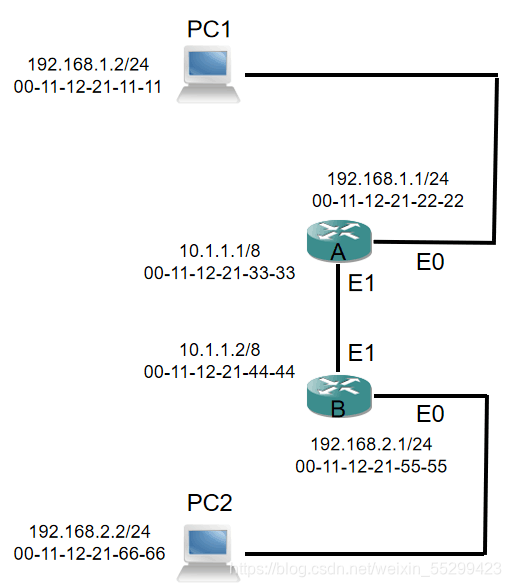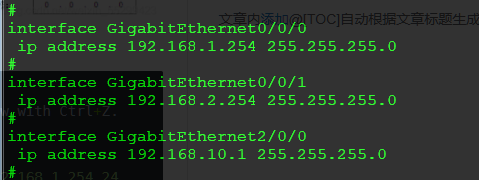6.网络技术——路由器原理:静态路由+默认路由(后附实验习题)
本文共 7837 字,大约阅读时间需要 26 分钟。
目录
1.路由器的工作原理
路由器工作在osi七层参考模型的网络层,作用是用来将数据包转发到正确的目的地,并在转发过程中选择最佳路径
1.1路由表
路由表的定义:路由器中维护的路由条目的集合
路由器根据路由表做路径选择 路由表的形成: 1)直连网段 配置IP地址,端口UP状态,形成直连路由 2)非直连网段 1) 人工配置,静态路由 2)通过各种路由协议,自己学习,动态路由 对于非直连网段,需要静态路由或者动态路由,将网段添加到路由表中 路由表的格式:| 网段 | 接口 |
|---|---|
| - | - |
2.静态路由
静态路由:由管理员手工配置,是单向的
优点:便于排障,快速定位到出错,精准管理,有效管理 缺点:缺乏灵活性3.默认路由
默认路由:当路由器在路由表中好不到目标网络的路由条目时,路由器吧请求转发到默认路由接口
先查路由表,有路由表就走,路由表里面没有信息,就回复一个丢包信息 在路由表中找不到目标时,我们再做打算,人工配置地址 路由优先级 可配置(浮动路由) 数字越小,越优先4.路由器转发数据包的封装过程💨

 路由器有个功能 隔离广播 同一个局域网的范围之内 不隔离的话 会形成广播风暴
路由器有个功能 隔离广播 同一个局域网的范围之内 不隔离的话 会形成广播风暴 路由器的接口 每个都拥有MAC地址
路由器上也有ARP表5.交换机与路由器对比
路由器工作在网络层
1)根据“路由表”转发数据 2)路由选择 3)路由转发 交换机工作在数据链路层 1)根据“MAC地址表”转发数据 2)硬件转发6.静态路由和默认路由的配置

7.实验题
7.1 实验要求:在r1中配置默认路由,r2、r3配置静态路由,使内网1.0和2.0可以访问server
拓补图:



 r1使用的代码:
r1使用的代码: sysEnter system view, return user view with Ctrl+Z.[Huawei]sysname r1[r1]int g0/0/0[r1-GigabitEthernet0/0/0]ip add 192.168.1.254 24[r1-GigabitEthernet0/0/0]int g0/0/1[r1-GigabitEthernet0/0/1]ip add 192.168.2.254 24[r1-GigabitEthernet0/0/1]int g2/0/0[r1-GigabitEthernet2/0/0]ip add 192.168.10.1 24[r1-GigabitEthernet2/0/0]dis cu
查看端口信息:
 查看当前路由表信息,这个时候里面还什么都没有:
查看当前路由表信息,这个时候里面还什么都没有: [r1-GigabitEthernet2/0/0]q[r1]dis ip routing-table

[r1]ip route-static 0.0.0.0 0 192.168.10.2[r1]dis ip routing-table

r2使用的代码:
sysEnter system view, return user view with Ctrl+Z.[Huawei]sysname r2[r2]int g0/0/0[r2-GigabitEthernet0/0/0]ip add 192.168.10.2 24[r2-GigabitEthernet0/0/0]int g0/0/1[r2-GigabitEthernet0/0/1]ip add 192.168.20.1 24[r2-GigabitEthernet0/0/1]q[r2]ip route-static 10.0.0.0 8 192.168.20.2[r2]ip route-static 192.168.1.0 24 192.168.10.1[r2]ip route-static 192.168.2.0 24 192.168.10.1[r2]dis ip routing-table
查看配置好的静态路由信息:
 r3使用的代码:
r3使用的代码: sysEnter system view, return user view with Ctrl+Z.[Huawei]sysname r3[r3]int g0/0/0[r3-GigabitEthernet0/0/0]ip add 192.168.20.2 24[r3-GigabitEthernet0/0/0]int g0/0/1[r3-GigabitEthernet0/0/1]ip add 10.0.0.1 8[r3-GigabitEthernet0/0/1]q[r3]ip route-static 192.168.1.0 24 192.168.20.1[r3]ip route-static 192.168.2.0 24 192.168.20.1
这里步骤跟上面的一样,我这里就没有截图
然后来ping一下看看能否互连:

7.2 实验要求:全网互通
拓补图:



 r1的代码:
r1的代码: sysEnter system view, return user view with Ctrl+Z.[Huawei]sysname r1[r1]int g0/0/0[r1-GigabitEthernet0/0/0]ip add 20.0.0.1 24[r1-GigabitEthernet0/0/0]int g0/0/1[r1-GigabitEthernet0/0/1]ip add 30.0.0.1 24[r1-GigabitEthernet0/0/1]int g0/0/2[r1-GigabitEthernet0/0/2]ip add 192.168.10.254 24[r1-GigabitEthernet0/0/2]dis cu[r1-GigabitEthernet0/0/2]q[r1]ip route-static 192.168.20.0 24 20.0.0.2[r1]ip route-static 192.168.30.0 24 30.0.0.2[r1]dis ip routing-table

The device is running!sysEnter system view, return user view with Ctrl+Z.[Huawei]sysname r2[r2]int g0/0/0[r2-GigabitEthernet0/0/0]ip add 192.168.20.254 24[r2-GigabitEthernet0/0/0]int g0/0/1[r2-GigabitEthernet0/0/1]ip add 20.0.0.2 24[r2-GigabitEthernet0/0/1]dis cu[r2-GigabitEthernet0/0/1]q[r2]dis ip routing-table [r2]ip route-static 192.168.10.0 24 20.0.0.1[r2]ip route-static 192.168.30.0 24 20.0.0.1

The device is running!sysEnter system view, return user view with Ctrl+Z.[Huawei]sysname r3[r3]int g0/0/0[r3-GigabitEthernet0/0/0]ip add 192.168.30.254 24[r3-GigabitEthernet0/0/0]int g0/0/1[r3-GigabitEthernet0/0/1]ip add 30.0.0.2 24[r3-GigabitEthernet0/0/1]dis cu[r3]dis ip routing-table [r3]ip route-static 192.168.10.0 24 30.0.0.1[r3]ip route-static 192.168.20.0 24 30.0.0.1[r3]dis ip routing-table




7.3 实验要求:
1.配置浮动路由,实现pc1到pc2互连
2.断开r1和r2之间的其中一条链路,观察路由表的变化,pc1和pc2依然可以通信
拓补图:


 r1的代码:
r1的代码: The device is running!sysEnter system view, return user view with Ctrl+Z.[Huawei]sysname r1[r1]int g0/0/0[r1-GigabitEthernet0/0/0]ip add 192.168.10.254 24[r1-GigabitEthernet0/0/0]int g0/0/1[r1-GigabitEthernet0/0/1]ip add 10.0.0.1 24[r1-GigabitEthernet0/0/1]int g0/0/2[r1-GigabitEthernet0/0/2]ip add 20.0.0.1 24[r1-GigabitEthernet0/0/2]q[r1]ip route-static 192.168.20.0 24 10.0.0.2[r1]ip route-static 192.168.20.0 24 20.0.0.2[r1]ip route-static 192.168.20.0 24 20.0.0.2 pre [r1]ip route-static 192.168.20.0 24 20.0.0.2 preference 70Info: Succeeded in modifying route.[r1]dis ip routing-table

The device is running!sys[r2]int g0/0/0[r2-GigabitEthernet0/0/0]ip add 10.0.0.2 24[r2-GigabitEthernet0/0/0]int g0/0/1[r2-GigabitEthernet0/0/1]ip add 192.168.20.254 24[r2-GigabitEthernet0/0/1]int g0/0/2[r2-GigabitEthernet0/0/2]ip add 30.0.0.1 24[r2-GigabitEthernet0/0/2]q[r2]dis cu[r2]ip route-static 192.168.10.0 24 10.0.0.1[r2]ip route-static 192.168.10.0 24 30.0.0.2[r2]dis cu

The device is running!sysEnter system view, return user view with Ctrl+Z.[Huawei]sysname r3[r3]int g0/0/0[r3-GigabitEthernet0/0/0]ip add 20.0.0.2 24[r3-GigabitEthernet0/0/0]int g0/0/1[r3-GigabitEthernet0/0/1]ip add 30.0.0.2 24[r3-GigabitEthernet0/0/1]q[r3]dis cu sysEnter system view, return user view with Ctrl+Z.[r3]dis ip routing-table [r3]ip route-static 192.168.10.0 24 20.0.0.1[r3]ip route-static 192.168.20.0 24 30.0.0.1[r3]dis ip routing-table


 第二个小问是这里把r1跟r2之间的一条线断开,因为之前配置的优先级 在路由表里面是不现实的,这边断开 再重新查询一下就可以体现出来了 我这里吧r1的0/0/1口shutdown 代码如下:
第二个小问是这里把r1跟r2之间的一条线断开,因为之前配置的优先级 在路由表里面是不现实的,这边断开 再重新查询一下就可以体现出来了 我这里吧r1的0/0/1口shutdown 代码如下: sysEnter system view, return user view with Ctrl+Z.[r1]int g0/0/1[r1-GigabitEthernet0/0/1]shut [r1-GigabitEthernet0/0/1]shutdown Apr 4 2021 20:33:33-08:00 r1 %%01IFPDT/4/IF_STATE(l)[0]:Interface GigabitEthernet0/0/1 has turned into DOWN state.[r1-GigabitEthernet0/0/1]Apr 4 2021 20:33:33-08:00 r1 %%01IFNET/4/LINK_STATE(l)[1]:The line protocol IP on the interface GigabitEthernet0/0/1 has entered the DOWN state. [r1-GigabitEthernet0/0/1]
断开接口的样子 如图所示:
 这时候我们来看一下 之前设置的浮动路由 优先级就体现出来了 优先级 70
这时候我们来看一下 之前设置的浮动路由 优先级就体现出来了 优先级 70 [r1-GigabitEthernet0/0/1]q[r1]dis ip rou [r1]dis ip routing-table



7.4 实验要求(拓展):
11.实现全网互通
2.实验环境:三台路由器两两互连,每台路由器上都配置了Loopback地址模拟网络环境
拓补图:
 r1的代码:
r1的代码: sysEnter system view, return user view with Ctrl+Z.[Huawei]sysname r1[r1]int g0/0/0[r1-GigabitEthernet0/0/0]int g0/0/1[r1-GigabitEthernet0/0/1]ip add 192.168.30.1 24 [r1-GigabitEthernet0/0/1]q[r1]int LoopBack 0[r1-LoopBack0]ip add 1.1.1.1 32[r1-LoopBack0]q[r1]ip route-static 2.2.2.2 32 192.168.10.2[r1]ip route-static 2.2.2.2 32 192.168.30.2[r1]ip route-static 3.3.3.3 32 192.168.30.2[r1]ip route-static 3.3.3.3 32 192.168.10.2
然后在r1里面ping r2的地址
[r1]ping -a 1.1.1.1 2.2.2.2
源地址 + 目标地址
效果如图:

r2的代码:
sysEnter system view, return user view with Ctrl+Z.[Huawei]sysname r2[r2]int g0/0/0[r2-GigabitEthernet0/0/0]ip add 192.168.10.2 24[r2-GigabitEthernet0/0/0]int g0/0/1[r2-GigabitEthernet0/0/1]ip add 192.168.20.1 24[r2-GigabitEthernet0/0/1]q[r2]int LoopBack 0[r2-LoopBack0]ip add 2.2.2.2 32[r2-LoopBack0]q[r2]ip route-static 1.1.1.1 32 192.168.10.1[r2]ip route-static 1.1.1.1 32 192.168.20.2[r2]ip route-static 3.3.3.3 32 192.168.20.2[r2]ip route-static 3.3.3.3 32 192.168.10.1
同理在r2上面 ping r1 r3
r3的代码:
sys sys[Huawei]sysname r3[r3]int g0/0/0[r3-GigabitEthernet0/0/0]ip add 192.168.20.2 24[r3-GigabitEthernet0/0/0]int g0/0/1[r3-GigabitEthernet0/0/1]ip add 192.168.30.2 24[r3-GigabitEthernet0/0/1]q[r3]int LoopBack 0[r3-LoopBack0]ip add 3.3.3.3 32[r3-LoopBack0]q[r3]ip route-static 1.1.1.1 32 192.168.30.1[r3]ip route-static 1.1.1.1 32 192.168.20.1[r3]ip route-static 2.2.2.2 32 192.168.20.1[r3]ip route-static 2.2.2.2 32 192.168.30.1
同理在r3里面ping r1 r2
8.故障排查
分层检查:
从物理检查,查看端口状态来排除接口、线缆问题 查看IP地址和路由等的配置是否正确分段检查:
将网络划分成多个小的段,逐段排除错误转载地址:http://tpbe.baihongyu.com/
你可能感兴趣的文章
netmiko 自动判断设备类型python_Python netmiko模块的使用
查看>>
NetMizer-日志管理系统 dologin.php SQL注入漏洞复现(XVE-2024-37672)
查看>>
Netpas:不一样的SD-WAN+ 保障网络通讯品质
查看>>
netron工具简单使用
查看>>
NetScaler MPX Gateway Configuration
查看>>
NetScaler的常用配置
查看>>
netsh advfirewall
查看>>
NETSH WINSOCK RESET这条命令的含义和作用?
查看>>
netstat kill
查看>>
netstat命令用法详解
查看>>
Netstat端口占用情况
查看>>
Netty 4的内存管理:sun.misc.Unsafe
查看>>
Netty channelRegistered\ChannelActive---源码分析
查看>>
Netty NIO transport && OIO transport
查看>>
Netty WebSocket客户端
查看>>
netty 主要组件+黏包半包+rpc框架+源码透析
查看>>
Netty 异步任务调度与异步线程池
查看>>
Netty 解决TCP粘包/半包使用
查看>>
netty——Future和Promise的使用 线程间的通信
查看>>
netty——黏包半包的解决方案、滑动窗口的概念
查看>>